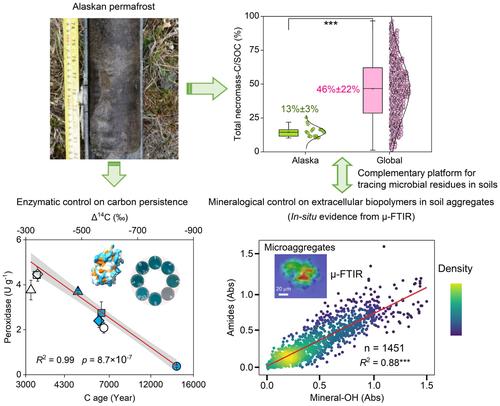当前位置:
X-MOL 学术
›
Glob. Change Biol.
›
论文详情
Our official English website, www.x-mol.net, welcomes your
feedback! (Note: you will need to create a separate account there.)
Deciphering the Intricate Control of Minerals on Deep Soil Carbon Stability and Persistence in Alaskan Permafrost
Global Change Biology ( IF 10.8 ) Pub Date : 2024-10-25 , DOI: 10.1111/gcb.17552 Yi‐Xuan Guo, Guang‐Hui Yu, Shuijin Hu, Chao Liang, Andreas Kappler, Mark Torre Jorgenson, Laodong Guo, Georg Guggenberger
Global Change Biology ( IF 10.8 ) Pub Date : 2024-10-25 , DOI: 10.1111/gcb.17552 Yi‐Xuan Guo, Guang‐Hui Yu, Shuijin Hu, Chao Liang, Andreas Kappler, Mark Torre Jorgenson, Laodong Guo, Georg Guggenberger

|
Understanding the fate of organic carbon in thawed permafrost is crucial for predicting climate feedback. While minerals and microbial necromass are known to play crucial roles in the long‐term stability of organic carbon in subsoils, their exact influence on carbon persistence in Arctic permafrost remains uncertain. Our study, combining radiocarbon dating and biomarker analyses, showed that soil organic carbon in Alaskan permafrost had millennial‐scale radiocarbon ages and contained only 10%–15% microbial necromass carbon, significantly lower than the global average of ~30%–60%. This ancient carbon exhibited a weak correlation with reactive minerals but a stronger correlation with mineral weathering (reactive iron to total iron ratio). Peroxidase activity displayed a high correlation coefficient (p < 10−6 ) with Δ14 C and δ13 C, indicating its strong predictive power for carbon persistence. Further, a positive correlation between peroxidase activity and polysaccharides indicates that increased peroxidase activity may promote the protection of plant residues, potentially by fostering the formation of mineral‐organic associations. This protective role of mineral surfaces on biopolymers was further supported by examining 1451 synchrotron radiation infrared spectra from soil aggregates, which revealed a strong correlation between mineral OH groups and organic functional groups at the submicron scale. An incubation experiment revealed that increased moisture contents, particularly within the 0%–40% range, significantly elevated peroxidase activity, suggesting that ancient carbon in permafrost soils is vulnerable to moisture‐induced destabilization. Collectively, this study offers mechanistic insights into the persistence of carbon in thawed permafrost soils, essential for refining permafrost carbon‐climate feedbacks.
中文翻译:

破译矿物对深层土壤碳稳定性和持久性的复杂控制阿拉斯加永久冻土
了解有机碳在融化的永久冻土中的归宿对于预测气候反馈至关重要。虽然已知矿物和微生物坏死量在底土中有机碳的长期稳定性中起着至关重要的作用,但它们对北极永久冻土中碳持久性的确切影响仍不确定。我们的研究结合了放射性碳测年和生物标志物分析,表明阿拉斯加永久冻土中的土壤有机碳具有千年尺度的放射性碳年龄,仅含有 10%-15% 的微生物坏死碳,明显低于 ~30%-60% 的全球平均水平。这种古老的碳与活性矿物的相关性较弱,但与矿物风化作用(活性铁与总铁的比率)的相关性较强。过氧化物酶活性与 Δ14C 和 δ13C 显示出高相关系数 (p < 10−6),表明其对碳持久性的强烈预测能力。此外,过氧化物酶活性与多糖之间的正相关表明,过氧化物酶活性的增加可能通过促进矿物-有机结合的形成来促进对植物残留物的保护。通过检查来自土壤聚集体的 1451 个同步辐射红外光谱,进一步支持了矿物表面对生物聚合物的这种保护作用,这揭示了矿物 OH 基团和有机官能团在亚微米尺度上具有很强的相关性。一项孵化实验表明,水分含量的增加,特别是在 0%-40% 范围内,显着提高了过氧化物酶活性,这表明永久冻土土壤中的古老碳容易受到水分诱导的不稳定。 总的来说,这项研究为碳在融化的永久冻土中的持久性提供了机理见解,这对于提炼永久冻土碳气候反馈至关重要。
更新日期:2024-10-25
中文翻译:

破译矿物对深层土壤碳稳定性和持久性的复杂控制阿拉斯加永久冻土
了解有机碳在融化的永久冻土中的归宿对于预测气候反馈至关重要。虽然已知矿物和微生物坏死量在底土中有机碳的长期稳定性中起着至关重要的作用,但它们对北极永久冻土中碳持久性的确切影响仍不确定。我们的研究结合了放射性碳测年和生物标志物分析,表明阿拉斯加永久冻土中的土壤有机碳具有千年尺度的放射性碳年龄,仅含有 10%-15% 的微生物坏死碳,明显低于 ~30%-60% 的全球平均水平。这种古老的碳与活性矿物的相关性较弱,但与矿物风化作用(活性铁与总铁的比率)的相关性较强。过氧化物酶活性与 Δ14C 和 δ13C 显示出高相关系数 (p < 10−6),表明其对碳持久性的强烈预测能力。此外,过氧化物酶活性与多糖之间的正相关表明,过氧化物酶活性的增加可能通过促进矿物-有机结合的形成来促进对植物残留物的保护。通过检查来自土壤聚集体的 1451 个同步辐射红外光谱,进一步支持了矿物表面对生物聚合物的这种保护作用,这揭示了矿物 OH 基团和有机官能团在亚微米尺度上具有很强的相关性。一项孵化实验表明,水分含量的增加,特别是在 0%-40% 范围内,显着提高了过氧化物酶活性,这表明永久冻土土壤中的古老碳容易受到水分诱导的不稳定。 总的来说,这项研究为碳在融化的永久冻土中的持久性提供了机理见解,这对于提炼永久冻土碳气候反馈至关重要。


















































 京公网安备 11010802027423号
京公网安备 11010802027423号